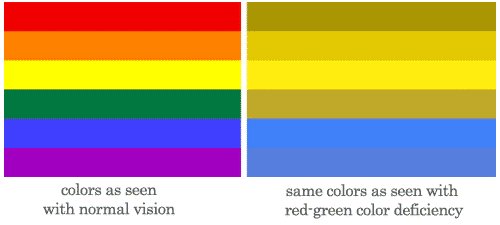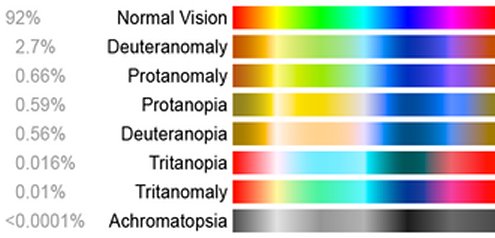Before I start to discuss colourblindness perhaps I should start by taking a moment to talk briefly about how it is that we are able to see colour in the first place. Now most people are familiar with the fact that at the back of our eyes, the retina, there are two groups of light sensitive cells that are called rods and cones based upon their shape. The rods are sensitive to the intensity of the light whatever the colour, if we had only rods we’d see everything in black and white, complete colourblindness.

The cones on the other hand come in three types; some are sensitive to the longer wavelengths of visible light, the colour red. Others are sensitive to the shorter visible wavelengths, the colour blue. The final group is sensitive to the middle wavelengths, the colour green. Together these three types of cones give us the ability to distinguish thousands of shades of colour.
Colourblindness is defined as a decreased ability to discern the full range of the colour spectrum of visible light. In other words some of the cone cells are not functioning properly.
The most common form of colourblindness consists of some degree of difficulty in distinguishing between the colours red and green and is known clinically as dichromatic. Dichromatic colourblindness is both genetic in nature and sex related since the gene for the red / green cone cells occurs on the X chromosome of the X-y sex pair.

The defective gene for colourblindness is recessive in nature so since women have two X sex chromosomes both of the chromosomes must have the defective gene in order for her to be colourblind. A woman with only a single defective X chromosome can be a ‘carrier’ of colourblindness however.

A male on the other hand has only one X sex chromosome, which he gets from his mother. Therefore if a woman is colourblind all of her male offspring will be colourblind. If a woman is only a carrier of colourblindness then half of her sons will inherit the defective gene and develop colourblindness. Because of this many more men are colourblind, about 8%, as opposed to women, 0.5%.
Colourblindness varies in degree with most colourblind people having only a small loss of colour vision. The chart below shows the different recognized ‘types’ of colourblindness along with the percentage of the population effected.

Determining whether of not a person has colourblindness is usually accomplished by testing them with one or more Ishihara colour test plates, an example of which is given below. In this example a person with normal colour vision can clearly see the number 27 in the center of the design while a person with a slight colour deficiency will see the number 21. A person with total red / green colourblindness will not see any number at all!

There is no cure for colourblindness. Recently however there have been attempts to ‘correct’ colourblindness with specially designed glasses in a manner similar to the way that near or farsightedness can be corrected. The glasses are commercially available under the trademarked name EnChroma® and were developed by developed by a pair of scientists, Andrew Schmeder, a mathematician who studies the psychology of perception, and Don McPherson a glass researcher who has invented specialized laser safety glasses for surgeons.

According to the inventors the EnChroma® glasses work by eliminating just those wavelengths of red and green light that confuse the eye’s cone cell receptor which allows the brain to perceive a greater colour contrast. EnChroma® Inc. estimates that 80% of colourblind people can see improved colour vision with the help of the glasses and judging by the reaction in Youtube videos of colourblind people who try them for the first time they succeed miraculously.
Not everybody is so convinced however. Researchers at the University of Grenada’s department of Optics in Spain have conducted a test of the EnChroma® glasses with 48 colourblind individuals, over 200 people volunteered for the test. The results of this study, which were published in the journal Optics Express, seem to show that the EnChroma® glasses only marginally perform better than ordinary hunting glasses at increasing colour perception. The conclusion reached was that the wearers of EnChroma® do not perceive new colours so much as see the same colours in a new way.
Sounds a bit like we’re arguing semantics to me. While it’s true that the claims made by EnChroma® Inc are exaggerated, they’re trying to sell the glasses after all, the company has never claimed to be able to ‘cure’ colourblindness. Reality is probably somewhere in the middle with the EnChroma® glasses allowing people with a mild form of red / green colourblindness to separate the two colours more readily.
And at least that’s a start. The development of EnChroma® glasses is the first even slightly successful treatment for colourblindness. Hopefully in the years to come improved versions of the glasses will be developed that perform better, and for more types of colourblindness.
In the long run there has been some research conducted by Maureen Neitz at the University of Washington that has employed gene therapy to cure colourblindness in monkeys. It may in fact be only a few years before there are some treatments available that can significantly improve the ability of people born with colourblindness to see the world with all of the rich tapestry of colours the rest of us take for granted everyday.
